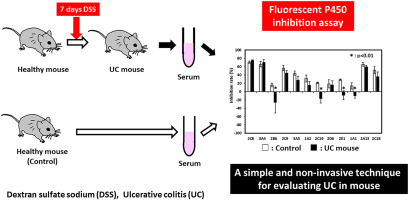Chemico-Biological Interactions ( IF 5.1 ) Pub Date : 2018-05-26 , DOI: 10.1016/j.cbi.2018.05.012 Ryuichi Yamamoto , Kouhei Muroi , Hiromasa Imaishi

|
Ulcerative colitis (UC) is characterized by erosions of the intestinal mucosa. The number of patients with UC has recently been increasing rapidly. Since the diagnosis of UC is complex and difficult, a simple, rapid, noninvasive technique for diagnosing UC is needed urgently. The expression of cytochrome P450 (P450 or CYP) species in mouse liver is known to be changed dependent on the disease. Various components such as P450 substrates and P450 metabolites in the blood may possibly change with the UC-specific way in mouse. In this study, in order to evaluate UC-specific components in UC mouse serum, we analyzed the influence of serum derived from UC mice on the results of fluorescent P450 inhibition assays based on 12 human P450 enzymes, such as CYP1A1, CYP2C8, CYP2E1,CYP3A4, CYP1A2, CYP2D6, CYP2A13, CYP2B6, CYP2C9, CYP2C18, CYP2C19, and CYP3A5. At first, in order to induce UC, mice received 4,4-dimethyl-4-silapentane-1-sulfonic acid (DSS) dissolved in their drinking water for 7 days. Next, these 12 human P450 enzymes were expressed in E. coli cells. Then, P450 fluorescent competition reaction was performed using these P450 enzymes and serum of UC mice. We found that the metabolism of fluorescent substrates by CYP2B6, CYP2C19, CYP2E1, and CYP1A1 in the presence of serum obtained from DSS-treated mice was activated by 42%, 37%, 37%, and 23%, respectively, relative to that associated with sera from control mice. A receiver operating characteristic (ROC) curve analysis was carried out with the 31 samples of UC mice and healthy mice. Area under the ROC curve (AUC) value was calculated from ROC curve. AUC value of CYP2E1 and CYP2C19 showed 0.921 and 0.892, respectively. Therefore, it was shown that CYP2C19 and CYP2E1 could be used as biomarkers for evaluating ulcerative colitis. From these results, it is suggested that these simple fluorescent P450 inhibition assays have potential as a new diagnostic procedure for UC in mouse. This study is the first report on a simple non-invasive method for evaluating UC using P450 enzyme and serum interaction.
中文翻译:

溃疡性结肠炎小鼠血清取决于疾病进展程度,可通过P450改变荧光底物的代谢
溃疡性结肠炎(UC)的特征是肠粘膜糜烂。UC患者的数量最近迅速增加。由于UC的诊断非常复杂且困难,因此迫切需要一种简单,快速,无创的UC诊断技术。已知小鼠肝脏中细胞色素P450(P450或CYP)物种的表达会根据疾病而改变。血液中的各种成分(例如P450底物和P450代谢物)可能会以UC特异性方式在小鼠中发生变化。在这项研究中,为了评估UC小鼠血清中的UC特异性成分,我们分析了UC小鼠血清对基于12种人类P450酶(例如CYP1A1,CYP2C8,CYP2E1, CYP3A4,CYP1A2,CYP2D6,CYP2A13,CYP2B6,CYP2C9,CYP2C18,CYP2C19和CYP3A5。首先,为了诱导UC,小鼠接受在其饮用水中溶解7天的4,4-二甲基-4-硅戊烷-1-磺酸(DSS)。接下来,这12种人类P450酶在大肠杆菌细胞。然后,使用这些P450酶和UC小鼠的血清进行P450荧光竞争反应。我们发现,在存在DSS处理的小鼠血清的情况下,CYP2B6,CYP2C19,CYP2E1和CYP1A1对荧光底物的代谢分别被激活了42%,37%,37%和23%。对照小鼠的血清。用UC小鼠和健康小鼠的31个样本进行了接收者操作特征(ROC)曲线分析。根据ROC曲线计算ROC曲线下面积(AUC)。CYP2E1和CYP2C19的AUC值分别为0.921和0.892。因此,显示CYP2C19和CYP2E1可用作评估溃疡性结肠炎的生物标志物。根据这些结果,提示这些简单的荧光P450抑制测定法有可能作为小鼠UC的新诊断方法。这项研究是有关使用P450酶和血清相互作用评估UC的简单非侵入性方法的第一份报告。


























 京公网安备 11010802027423号
京公网安备 11010802027423号